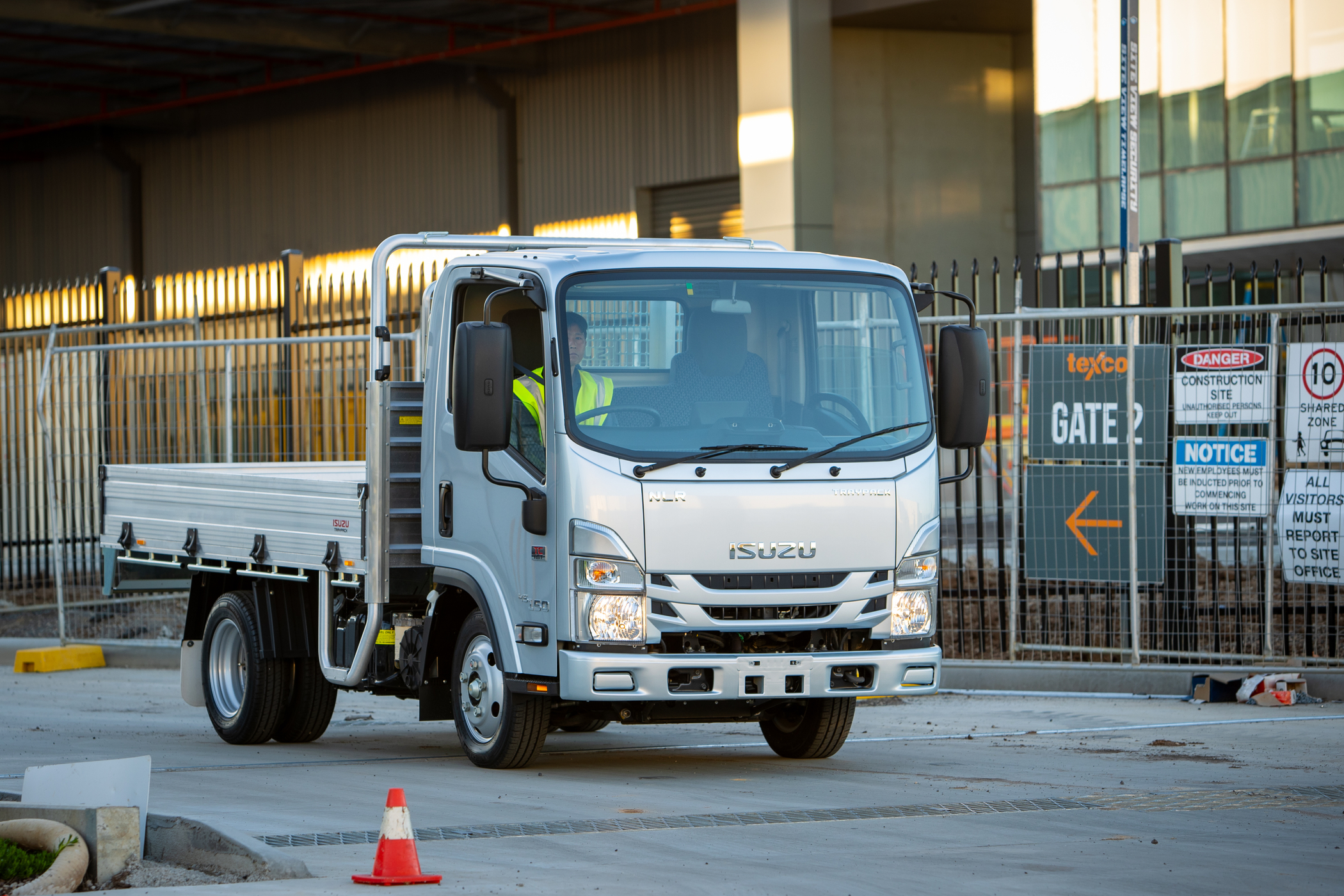TRUCKSALES.COM.AU - Isuzu NMR 60-150: Allan Whiting Review
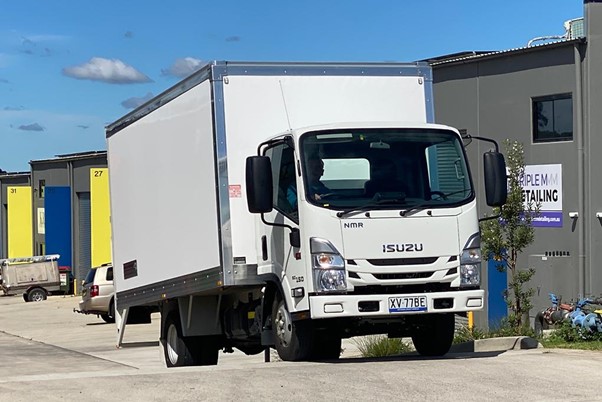
We're jumping into as many variants of the newly updated Isuzu N Series range as we can. Here’s a week-long review of the new NMR 60-150 narrow-cab model.
In the past, there were often compromises when you climbed aboard a narrow-cab variant: squeezy accommodation and worse ride quality were common issues. However, Isuzu’s new NMR is different, because this narrow-cab model comes with a very comfortable driver’s seat that has its own suspension.
Unlike some competitive seats it’s also very easy to adjust the driver’s weight setting, for optimal suspension action.
The NMR already came with coil-spring, wishbone front suspension, so ride quality in the unsprung passenger beach was OK, but was made even better for the driver. We sought out plenty of rough roads for this test – not difficult in rain-drenched Sydney – and were very impressed with the NMR’s behaviour.
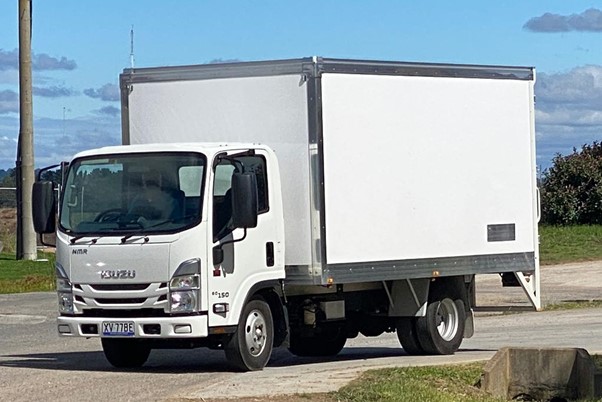 Isuzu's N Series has recently been updated.
At six tonnes GVM the NMR was probably as far as Isuzu plans to go with the ubiquitous 4JJ engine. The company must have made millions of these three-litre, four-cylinder, intercooled turbo-diesels that have powered pickups and light trucks around the world, as well as serving industrial power applications.
In Isuzu and Chevrolet utes and wagons the engine is rated up to 140kW and 450Nm, but in the NMR it was capped at 110kW and 375Nm in the interests of longevity at higher-GVM loads. The NMR has 4495-6000kg GVM, with a GCM of 9500kg.
Our test vehicle handled a car-licence 4.5-tonnes GVM without issue, but our prior experience with the 5.2-litre, 114kW/419Nm NPR showed that it handled six-tonnes-GVM in hilly terrain with less effort. Also, the larger engine had much more effective exhaust braking.
However, the NMR had certain plusses for urban operators, including better ride quality from its independent front suspension and easier tight-spot access provided by the narrow cab. I could easily park it in an open shopping centre car-park space, making urban deliveries a breeze.
Isuzu's N Series has recently been updated.
At six tonnes GVM the NMR was probably as far as Isuzu plans to go with the ubiquitous 4JJ engine. The company must have made millions of these three-litre, four-cylinder, intercooled turbo-diesels that have powered pickups and light trucks around the world, as well as serving industrial power applications.
In Isuzu and Chevrolet utes and wagons the engine is rated up to 140kW and 450Nm, but in the NMR it was capped at 110kW and 375Nm in the interests of longevity at higher-GVM loads. The NMR has 4495-6000kg GVM, with a GCM of 9500kg.
Our test vehicle handled a car-licence 4.5-tonnes GVM without issue, but our prior experience with the 5.2-litre, 114kW/419Nm NPR showed that it handled six-tonnes-GVM in hilly terrain with less effort. Also, the larger engine had much more effective exhaust braking.
However, the NMR had certain plusses for urban operators, including better ride quality from its independent front suspension and easier tight-spot access provided by the narrow cab. I could easily park it in an open shopping centre car-park space, making urban deliveries a breeze.
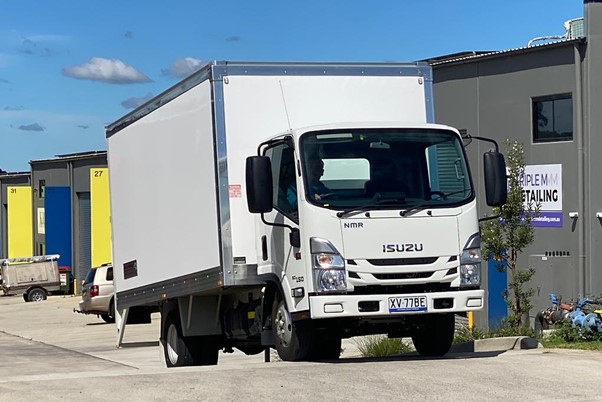 The 3.0-litre 4JJ diesel engine has been around for years but it's nearly bulletproof.
Also, the torque-converter-equipped automated manual transmission was much sweeter-shifting than its predecessors. It didn’t have the power-shift, unbroken torque delivery of a full automatic, but was quite up to the urban task.
Mechanically, the 2022 Isuzu NMR wasn’t much different from the 2021 range, but in terms of safety equipment it caught up with the competition and, in some aspects, surpassed it.
The 3.0-litre 4JJ diesel engine has been around for years but it's nearly bulletproof.
Also, the torque-converter-equipped automated manual transmission was much sweeter-shifting than its predecessors. It didn’t have the power-shift, unbroken torque delivery of a full automatic, but was quite up to the urban task.
Mechanically, the 2022 Isuzu NMR wasn’t much different from the 2021 range, but in terms of safety equipment it caught up with the competition and, in some aspects, surpassed it.
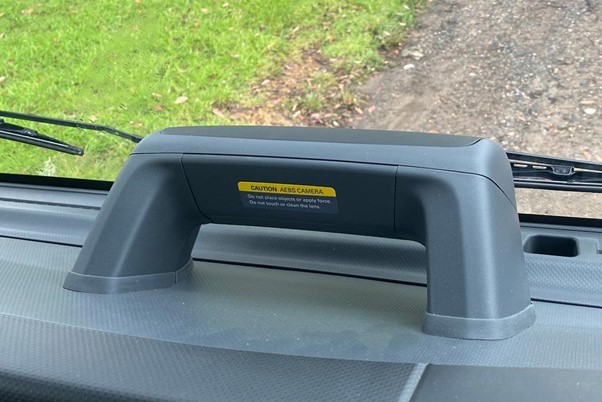 The centre-piece of the ADAS system is a pair of cameras mounted on the top of the dash.
The literal ‘eyes’ of the 2022 ADAS kit are a pair of stereoscopically-arranged, forward-facing cameras. The system is similar to that used in Isuzu D-MAX utes and MU-X wagons, and Subaru’s ‘Eyesight'.
In the new N Series the cameras are fitted into an inverted- U-shaped bar that mounts on the front parcel shelf, just behind the lower section of the windscreen. The twin cameras monitor everything in front of the vehicle and measure distance in the same way that human eyes do.
Isuzu chose the stereo-camera solution rather than radar-lidar, because the camera system was shown to be more effective at spotting small objects in front of the truck – think children – where the laser/sound wave system is better at longer-range distance measuring accuracy.
When ADAS finds its way into heavier Isuzus, the company may well use a combination of cameras and radar-lidar.
Although I didn’t get the opportunity to test the AEB function in the NMR test truck, I have had previous experience with the almost identical Subaru Eyesight system. The Subaru test involved driving the car towards an inflated, life-sized car balloon, in a controlled environment.
The centre-piece of the ADAS system is a pair of cameras mounted on the top of the dash.
The literal ‘eyes’ of the 2022 ADAS kit are a pair of stereoscopically-arranged, forward-facing cameras. The system is similar to that used in Isuzu D-MAX utes and MU-X wagons, and Subaru’s ‘Eyesight'.
In the new N Series the cameras are fitted into an inverted- U-shaped bar that mounts on the front parcel shelf, just behind the lower section of the windscreen. The twin cameras monitor everything in front of the vehicle and measure distance in the same way that human eyes do.
Isuzu chose the stereo-camera solution rather than radar-lidar, because the camera system was shown to be more effective at spotting small objects in front of the truck – think children – where the laser/sound wave system is better at longer-range distance measuring accuracy.
When ADAS finds its way into heavier Isuzus, the company may well use a combination of cameras and radar-lidar.
Although I didn’t get the opportunity to test the AEB function in the NMR test truck, I have had previous experience with the almost identical Subaru Eyesight system. The Subaru test involved driving the car towards an inflated, life-sized car balloon, in a controlled environment.
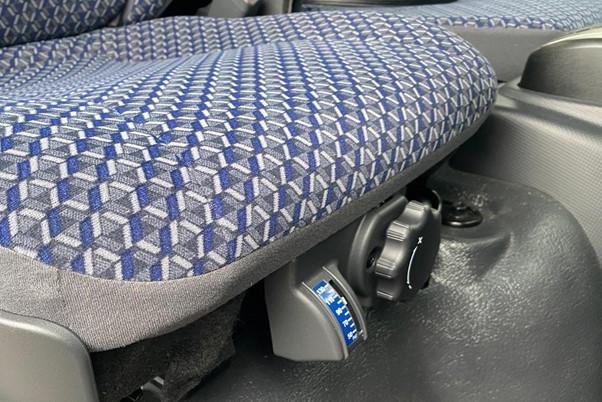 Easy adjustment of the suspension seat for the weight of the driver.
As the Subaru approached the ‘target’ the proximity alarm went off; the system signalled the need for heavy braking and, when I did nothing, AEB applied the brakes very aggressively, pulling up the car before contact. That’s what the N Series AEB system is designed to do as well.
Easy adjustment of the suspension seat for the weight of the driver.
As the Subaru approached the ‘target’ the proximity alarm went off; the system signalled the need for heavy braking and, when I did nothing, AEB applied the brakes very aggressively, pulling up the car before contact. That’s what the N Series AEB system is designed to do as well.
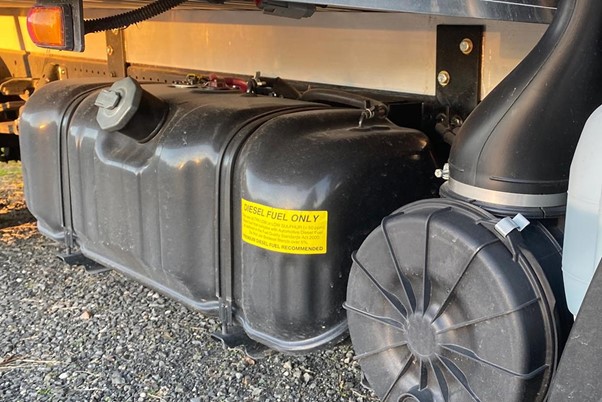 Short-wheelbase versions get a 75-litre fuel tank while long-wheelbase versions get a 100-litre tank.
In operation, that screen remained in place, but if the AEB camera software calculated that the truck was driving too close to the vehicle in front, it issued a medium-decibel chime – not obtrusive, I judged – and a small orange warning display suggested maintaining a safe distance. It had no retarding effect on cruise control, not did it apply any braking. The DWS function is designed to be purely advisory.
I found the same non-invasive behaviour with the LDW, lane departure warning function. A rocker switch provided two levels of sensitivity in this operation. With the display’s green ‘tram tracks’ set at their narrowest the LDW chime occurred when the bodywork or a tyre encountered a lane or fog-line marking. There was no correcting steering input, just a subtle chime to warn the driver that the truck was straying from its lane.
After few days’ experience with the LDW system I found that this tighter-lane setting was best for multi-lane roads, where lane indiscipline can cost a mirror breakage.
Related reading:
Isuzu 45-155 Tradepack: Review
Isuzu celebrates 50 years in Australia
N Series shines on Isuzu drive day
With the switch at its wider ‘tram track’ setting the LDW chime didn’t sound until the tyre or bodywork was actually over the lane marking. I chose this setting when driving on narrow, secondary roads, where a little fog-line overrun or broken centre lane intrusion wasn’t risky.
I didn’t find the Isuzu N Series ADAS in any way intrusive or annoying. In fact, it was a useful guide to maintaining a safe distance and keeping on the straight and narrow. However, for those who can’t abide any criticism of their driving style, there’s an ‘opt out’ button on the dashboard. It needs to be pressed after every engine start, or the ADAS defaults to operating condition. The reason for that is that Isuzu wants the driver to make the decision to make truck less safe, not the other way around.
Short-wheelbase versions get a 75-litre fuel tank while long-wheelbase versions get a 100-litre tank.
In operation, that screen remained in place, but if the AEB camera software calculated that the truck was driving too close to the vehicle in front, it issued a medium-decibel chime – not obtrusive, I judged – and a small orange warning display suggested maintaining a safe distance. It had no retarding effect on cruise control, not did it apply any braking. The DWS function is designed to be purely advisory.
I found the same non-invasive behaviour with the LDW, lane departure warning function. A rocker switch provided two levels of sensitivity in this operation. With the display’s green ‘tram tracks’ set at their narrowest the LDW chime occurred when the bodywork or a tyre encountered a lane or fog-line marking. There was no correcting steering input, just a subtle chime to warn the driver that the truck was straying from its lane.
After few days’ experience with the LDW system I found that this tighter-lane setting was best for multi-lane roads, where lane indiscipline can cost a mirror breakage.
Related reading:
Isuzu 45-155 Tradepack: Review
Isuzu celebrates 50 years in Australia
N Series shines on Isuzu drive day
With the switch at its wider ‘tram track’ setting the LDW chime didn’t sound until the tyre or bodywork was actually over the lane marking. I chose this setting when driving on narrow, secondary roads, where a little fog-line overrun or broken centre lane intrusion wasn’t risky.
I didn’t find the Isuzu N Series ADAS in any way intrusive or annoying. In fact, it was a useful guide to maintaining a safe distance and keeping on the straight and narrow. However, for those who can’t abide any criticism of their driving style, there’s an ‘opt out’ button on the dashboard. It needs to be pressed after every engine start, or the ADAS defaults to operating condition. The reason for that is that Isuzu wants the driver to make the decision to make truck less safe, not the other way around.
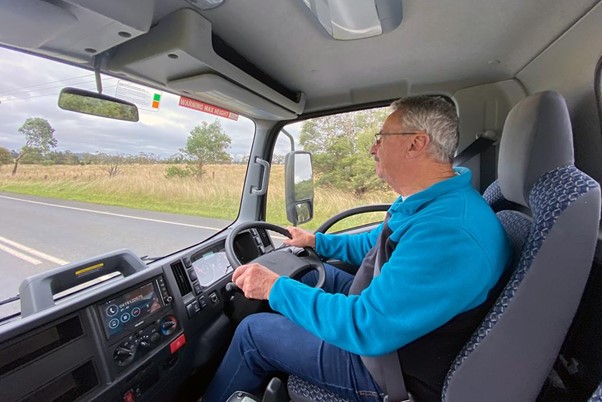 There's plenty of room and it's not uncomfortable.
When the ADAS-off button was pressed, orange DWS and LDW icons appeared on the instrument panel, clearly indicating that the system was disabled.
There's plenty of room and it's not uncomfortable.
When the ADAS-off button was pressed, orange DWS and LDW icons appeared on the instrument panel, clearly indicating that the system was disabled.
 The NMR is manoeuvrable and easy to park.
The NMR is manoeuvrable and easy to park.

 Isuzu's N Series has recently been updated.
At six tonnes GVM the NMR was probably as far as Isuzu plans to go with the ubiquitous 4JJ engine. The company must have made millions of these three-litre, four-cylinder, intercooled turbo-diesels that have powered pickups and light trucks around the world, as well as serving industrial power applications.
In Isuzu and Chevrolet utes and wagons the engine is rated up to 140kW and 450Nm, but in the NMR it was capped at 110kW and 375Nm in the interests of longevity at higher-GVM loads. The NMR has 4495-6000kg GVM, with a GCM of 9500kg.
Our test vehicle handled a car-licence 4.5-tonnes GVM without issue, but our prior experience with the 5.2-litre, 114kW/419Nm NPR showed that it handled six-tonnes-GVM in hilly terrain with less effort. Also, the larger engine had much more effective exhaust braking.
However, the NMR had certain plusses for urban operators, including better ride quality from its independent front suspension and easier tight-spot access provided by the narrow cab. I could easily park it in an open shopping centre car-park space, making urban deliveries a breeze.
Isuzu's N Series has recently been updated.
At six tonnes GVM the NMR was probably as far as Isuzu plans to go with the ubiquitous 4JJ engine. The company must have made millions of these three-litre, four-cylinder, intercooled turbo-diesels that have powered pickups and light trucks around the world, as well as serving industrial power applications.
In Isuzu and Chevrolet utes and wagons the engine is rated up to 140kW and 450Nm, but in the NMR it was capped at 110kW and 375Nm in the interests of longevity at higher-GVM loads. The NMR has 4495-6000kg GVM, with a GCM of 9500kg.
Our test vehicle handled a car-licence 4.5-tonnes GVM without issue, but our prior experience with the 5.2-litre, 114kW/419Nm NPR showed that it handled six-tonnes-GVM in hilly terrain with less effort. Also, the larger engine had much more effective exhaust braking.
However, the NMR had certain plusses for urban operators, including better ride quality from its independent front suspension and easier tight-spot access provided by the narrow cab. I could easily park it in an open shopping centre car-park space, making urban deliveries a breeze.
 The 3.0-litre 4JJ diesel engine has been around for years but it's nearly bulletproof.
Also, the torque-converter-equipped automated manual transmission was much sweeter-shifting than its predecessors. It didn’t have the power-shift, unbroken torque delivery of a full automatic, but was quite up to the urban task.
Mechanically, the 2022 Isuzu NMR wasn’t much different from the 2021 range, but in terms of safety equipment it caught up with the competition and, in some aspects, surpassed it.
The 3.0-litre 4JJ diesel engine has been around for years but it's nearly bulletproof.
Also, the torque-converter-equipped automated manual transmission was much sweeter-shifting than its predecessors. It didn’t have the power-shift, unbroken torque delivery of a full automatic, but was quite up to the urban task.
Mechanically, the 2022 Isuzu NMR wasn’t much different from the 2021 range, but in terms of safety equipment it caught up with the competition and, in some aspects, surpassed it.
Isuzu’s ADAS
ADAS (Advanced Driver Assistance Systems) in the latest 4x2 N Series includes: AEB (Advanced Emergency Braking); DWS (Distance Warning System); TMW (Traffic Movement Warning); ESC (Electronic Stability Control) and LDW (Lane Departure Warning). These electronic aids are in addition to the already existing safety systems: ECE R29 safety cab structure; dual SRS airbags; seat-belt pre-tensioners; ABS brakes; ASR skid-reduction; ALS (automatic lights-on); hill-start assistance; cruise control with speed limiter and cornering lights. The centre-piece of the ADAS system is a pair of cameras mounted on the top of the dash.
The literal ‘eyes’ of the 2022 ADAS kit are a pair of stereoscopically-arranged, forward-facing cameras. The system is similar to that used in Isuzu D-MAX utes and MU-X wagons, and Subaru’s ‘Eyesight'.
In the new N Series the cameras are fitted into an inverted- U-shaped bar that mounts on the front parcel shelf, just behind the lower section of the windscreen. The twin cameras monitor everything in front of the vehicle and measure distance in the same way that human eyes do.
Isuzu chose the stereo-camera solution rather than radar-lidar, because the camera system was shown to be more effective at spotting small objects in front of the truck – think children – where the laser/sound wave system is better at longer-range distance measuring accuracy.
When ADAS finds its way into heavier Isuzus, the company may well use a combination of cameras and radar-lidar.
Although I didn’t get the opportunity to test the AEB function in the NMR test truck, I have had previous experience with the almost identical Subaru Eyesight system. The Subaru test involved driving the car towards an inflated, life-sized car balloon, in a controlled environment.
The centre-piece of the ADAS system is a pair of cameras mounted on the top of the dash.
The literal ‘eyes’ of the 2022 ADAS kit are a pair of stereoscopically-arranged, forward-facing cameras. The system is similar to that used in Isuzu D-MAX utes and MU-X wagons, and Subaru’s ‘Eyesight'.
In the new N Series the cameras are fitted into an inverted- U-shaped bar that mounts on the front parcel shelf, just behind the lower section of the windscreen. The twin cameras monitor everything in front of the vehicle and measure distance in the same way that human eyes do.
Isuzu chose the stereo-camera solution rather than radar-lidar, because the camera system was shown to be more effective at spotting small objects in front of the truck – think children – where the laser/sound wave system is better at longer-range distance measuring accuracy.
When ADAS finds its way into heavier Isuzus, the company may well use a combination of cameras and radar-lidar.
Although I didn’t get the opportunity to test the AEB function in the NMR test truck, I have had previous experience with the almost identical Subaru Eyesight system. The Subaru test involved driving the car towards an inflated, life-sized car balloon, in a controlled environment.
 Easy adjustment of the suspension seat for the weight of the driver.
As the Subaru approached the ‘target’ the proximity alarm went off; the system signalled the need for heavy braking and, when I did nothing, AEB applied the brakes very aggressively, pulling up the car before contact. That’s what the N Series AEB system is designed to do as well.
Easy adjustment of the suspension seat for the weight of the driver.
As the Subaru approached the ‘target’ the proximity alarm went off; the system signalled the need for heavy braking and, when I did nothing, AEB applied the brakes very aggressively, pulling up the car before contact. That’s what the N Series AEB system is designed to do as well.
Non-irritating lane and distance warnings
Lane-keeping and distance-setting electronic aids have been part of the car and SUV world for years and, for the most part, are criticised by drivers for their intrusive nature. Many car and truck drivers get so fed up with bells, chimes and steering wheel ‘tugs’ that they turn everything off that they can. Thankfully, Isuzu’s ADAS kit is much more driver-friendly. When I fired up the NMR the dashboard display showed a small green screen with the DWS distance measurement icon showing the level of distance selected. The driver is able to lengthen or shorten that selected distance, within its range limits. Short-wheelbase versions get a 75-litre fuel tank while long-wheelbase versions get a 100-litre tank.
In operation, that screen remained in place, but if the AEB camera software calculated that the truck was driving too close to the vehicle in front, it issued a medium-decibel chime – not obtrusive, I judged – and a small orange warning display suggested maintaining a safe distance. It had no retarding effect on cruise control, not did it apply any braking. The DWS function is designed to be purely advisory.
I found the same non-invasive behaviour with the LDW, lane departure warning function. A rocker switch provided two levels of sensitivity in this operation. With the display’s green ‘tram tracks’ set at their narrowest the LDW chime occurred when the bodywork or a tyre encountered a lane or fog-line marking. There was no correcting steering input, just a subtle chime to warn the driver that the truck was straying from its lane.
After few days’ experience with the LDW system I found that this tighter-lane setting was best for multi-lane roads, where lane indiscipline can cost a mirror breakage.
Related reading:
Isuzu 45-155 Tradepack: Review
Isuzu celebrates 50 years in Australia
N Series shines on Isuzu drive day
With the switch at its wider ‘tram track’ setting the LDW chime didn’t sound until the tyre or bodywork was actually over the lane marking. I chose this setting when driving on narrow, secondary roads, where a little fog-line overrun or broken centre lane intrusion wasn’t risky.
I didn’t find the Isuzu N Series ADAS in any way intrusive or annoying. In fact, it was a useful guide to maintaining a safe distance and keeping on the straight and narrow. However, for those who can’t abide any criticism of their driving style, there’s an ‘opt out’ button on the dashboard. It needs to be pressed after every engine start, or the ADAS defaults to operating condition. The reason for that is that Isuzu wants the driver to make the decision to make truck less safe, not the other way around.
Short-wheelbase versions get a 75-litre fuel tank while long-wheelbase versions get a 100-litre tank.
In operation, that screen remained in place, but if the AEB camera software calculated that the truck was driving too close to the vehicle in front, it issued a medium-decibel chime – not obtrusive, I judged – and a small orange warning display suggested maintaining a safe distance. It had no retarding effect on cruise control, not did it apply any braking. The DWS function is designed to be purely advisory.
I found the same non-invasive behaviour with the LDW, lane departure warning function. A rocker switch provided two levels of sensitivity in this operation. With the display’s green ‘tram tracks’ set at their narrowest the LDW chime occurred when the bodywork or a tyre encountered a lane or fog-line marking. There was no correcting steering input, just a subtle chime to warn the driver that the truck was straying from its lane.
After few days’ experience with the LDW system I found that this tighter-lane setting was best for multi-lane roads, where lane indiscipline can cost a mirror breakage.
Related reading:
Isuzu 45-155 Tradepack: Review
Isuzu celebrates 50 years in Australia
N Series shines on Isuzu drive day
With the switch at its wider ‘tram track’ setting the LDW chime didn’t sound until the tyre or bodywork was actually over the lane marking. I chose this setting when driving on narrow, secondary roads, where a little fog-line overrun or broken centre lane intrusion wasn’t risky.
I didn’t find the Isuzu N Series ADAS in any way intrusive or annoying. In fact, it was a useful guide to maintaining a safe distance and keeping on the straight and narrow. However, for those who can’t abide any criticism of their driving style, there’s an ‘opt out’ button on the dashboard. It needs to be pressed after every engine start, or the ADAS defaults to operating condition. The reason for that is that Isuzu wants the driver to make the decision to make truck less safe, not the other way around.
 There's plenty of room and it's not uncomfortable.
When the ADAS-off button was pressed, orange DWS and LDW icons appeared on the instrument panel, clearly indicating that the system was disabled.
There's plenty of room and it's not uncomfortable.
When the ADAS-off button was pressed, orange DWS and LDW icons appeared on the instrument panel, clearly indicating that the system was disabled.
‘Camera halt’
I know from experience with the similar ADAS used in the Isuzu Ute D-MAX that there are times when the system bails out. For example, heavy rain can trigger a ‘camera halt’ condition, because the camera can’t see through a torrential downpour. In the case of the D-MAX there’s no clear indication that the ADAS functions are temporarily disabled. Isuzu Truck obviously knew about this situation, because the N Series ADAS flashes a ‘camera halt’ message in place of the DWS green icon and, at the same time, an orange DWS icon and an orange LDW icon appear on the instrument display, showing the driver that the ADAS has stopped working. I drove through one of hundreds of torrential Autumn downpours in soggy Sydney during this test and the amount of water trigged a ‘camera halt’ condition. Within a few minutes the rain dissipated and ADAS automatically reinstated itself, so the green display re-appeared. The NMR is manoeuvrable and easy to park.
The NMR is manoeuvrable and easy to park.
Conclusion
My judgment of the new ADAS functions was highly positive and I’m a bloke who clings to his non-electronic LandCruiser 75 Series for Outback jaunts. I detest intrusive electronic systems that try to jerk the steering wheel out of your hands, or jam on the brakes erratically when running in adaptive cruise control, but I think that Isuzu Truck has managed to tread the fine line between helping and taking over. ADAS employs driver aids that don’t try to replace the driver. It could even spur a driver challenge in pick-up and delivery fleets, to drive an entire shift without a single chime being heard. Specifications: Isuzu NMR 60-150 Pantech Engine: Isuzu 4JJ1-TCS, four-cylinder, 16-valve SOHC Displacement: Three litres Power: 150hp (110kW) at 2800rpm Torque: 375Nm at 1600 to 2800rpm Emission control: Cooled EGR with exhaust Diesel Particulate Filter (DPF), ADR 80/03 (Euro 5) Transmission: Automated manual six-speed with torque converter (six-speed manual available) GVM: 6000kg (4500kg optional) GCM: 8000kg (9500kg with manual transmission) Front axle: Independent, coil-spring, wishbone, 2600kg Rear axle: Full-floating banjo, 5000kg Diff ratio: 4.300:1 (4.777:1 with manual transmission) Brakes: Ventilated disc/disc with dual-circuit hydraulic control, vacuum assistance and EBD Park brake: Transmission-mounted 190mm drum Fuel tank: 75 litres (SWB), 100 litres (MWB)


Playtime’s over, get $3,500* to spend on extras.
If you’re ready to get serious about tackling bigger jobs, grab yourself an NLR 45-150 AMT SWB Traypack from the Ready-to-Work range for $62,990 drive away*. And to prove we aren’t playing, buy any NLR Traypack before June 30 and you’ll get $3,500* to spend on genuine accessories or an Essentials service agreement.
Learn more
